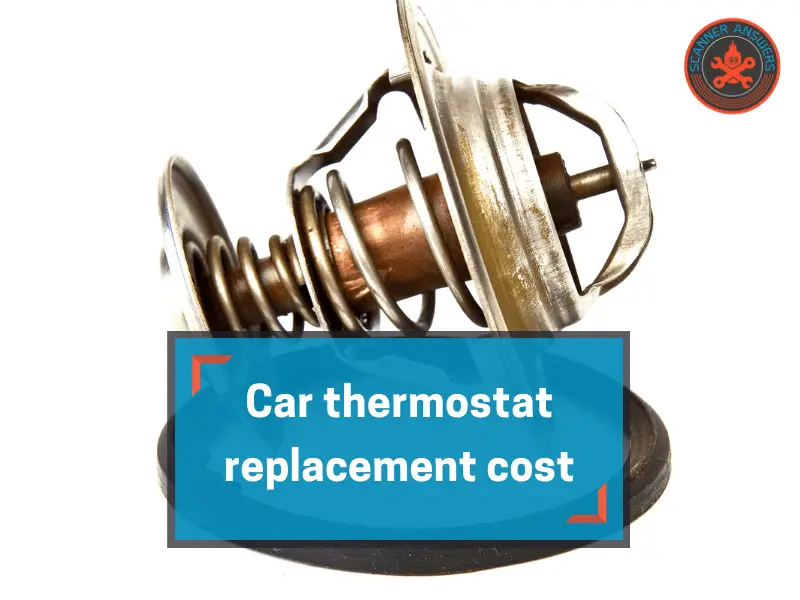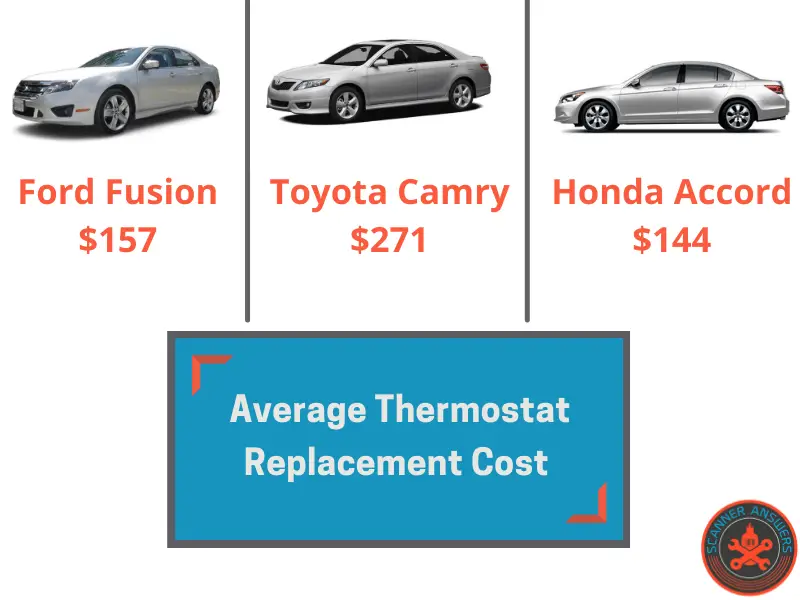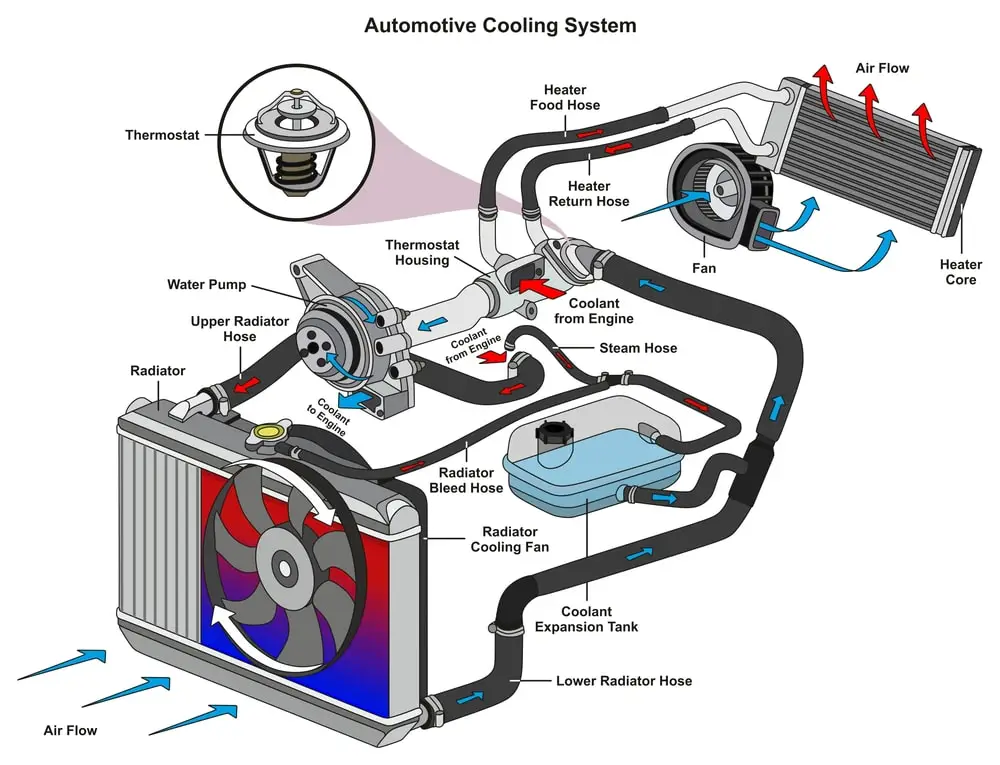At only two inches in diameter, a car’s thermostat is a small but mighty part of the whole. Without it, your vehicle’s cooling system can’t regulate temperature, and causes expensive damage like blown head gaskets.

On the other hand, the cost of replacing this device near the thermostat housing is relatively low. So how do you know when to fix it, and how much it will cost to replace or repair it?
In this article, we’ll compare car thermostat replacement costs in a few common vehicles and explain when you need to get that faulty thermostat replaced.
Thermostat Replacement Cost for Specific Vehicles

The cost to replace this crucial part can vary depending on where you live and what type of car you have. Compared to many other vehicle maintenance costs, a faulty thermostat replacement is relatively cheap.
This table outlines the cost in three different car models. These costs cover parts and labor and include an estimate for tax. Note: We have updated these costs for 2023 – 2024 in the table below. The cost of parts and labor has increased significantly since this article was originally written in 2021.
| Model | Parts | Labor | Total |
| Ford Fusion | $43-$75 | $92-$115 | $147-$190 |
| Toyota Camry | $49-$68 | $172-$227 | $221-$295 |
| Honda Accord | $45-$62 | $90-$116 | $135-$178 |
Fixing this part before you have coolant leaks or high operating temperature causing engine overheating will save you time and money!
So when should you get it replaced? Let’s dive deeper into the possible causes and signs of a bad thermostat.

What Does the Thermostat Do?
To understand why your thermostat might be malfunctioning, you first need to know how it works.
Car engines depend on temperature control. If the engine is too cool, the car won’t run efficiently, working harder to keep the engine running. Too hot, and the whole system can burn itself out.
A vehicle’s cooling system involves two parts:
- Engine assembly block
- Radiator
Coolant/Antifreeze/Propylene Glycol flows between these two via special coolant hoses and helps keep the engine temperature low enough to avoid melted pistons.
The thermostat is the valve that controls coolant flow between those two systems, consisting of a rod set inside a cylinder filled with wax. As the engine heats the cylinder, the wax starts to melt and expand, pushing the rod up and opening the valve to allow coolant to flow. As the car cools back down, the valve closes again.
The thermostat reduces engine wear and emissions by blocking coolant while the car begins to heat up. The thermostat keeps the engine from overheating by releasing coolant when the car hits its optimal operating temperature. When this thermostat fails, your vehicle can’t regulate temperature, and the damage can be extensive.
How Long Does it Take to Replace a Car Thermostat?
Replacing a thermostat is a pretty straightforward job. If the engine hasn’t sustained damage and the maintenance doesn’t reveal other issues, you can have your thermostat replaced in about an hour – or even do it yourself.
That said, it may be a good idea to bring your car in if you’re experiencing issues. If you drove your car for any length of time with a broken thermostat, your engine may have overheated and caused more severe damage. Repairs on a damaged engine can take hours or a few days.
Symptoms of a Bad Thermostat?
A fault thermostat can malfunction in two ways, getting stuck open or getting stuck closed. It keeps your engine’s temperature within normal operating temperature.
Here are a few signs your thermostat needs replacement:
1. Slow Engine Warm Up
If your car is taking too long to warm up, or the heat isn’t working, your thermostat may be stuck open, allowing coolant to flow before the engine is warm. While this isn’t a huge safety risk before the engine temperature wont overheat, your vehicle will have to use more power to heat up and lose fuel efficiency.
2. High Temps On Dash Cluster Gauge
![]()
If the temperature gauge on your dashboard edges toward “hot,” you need to act immediately. A hot gauge may mean the thermostat is stuck closed, blocking any coolant from reaching the engine. Without coolant, the engine will overheat, causing potentially irreversible engine damage or even causing the engine to seize up.
3. CEL Illuminated

If your car’s Check Engine light comes on, it may be a closed thermostat issue. Always get your vehicle checked when your Check Engine light alerts you.
[su_icon_text icon=”icon: chevron-right” icon_color=”#00e002″]Check the OBD2 codes and see if a P0128 dtc is showing.[/su_icon_text]
How Long Does a Thermostat Last?
Theoretically, a new thermostat can last the entire life of your vehicle. They typically don’t wear down over time but can be damaged by outside factors like corrosion or debris buildup. However, you should replace it whenever you do a coolant flush which is about every 30,000 miles / 5 years.
If you suspect trouble, keep a close eye on your temperature gauge. If it’s getting too high, that’s your first indicator that your car engine could be getting too hot.
Since there’s no specific lifespan on a car thermostat, regular coolant system flushes will ensure everything is clean and running correctly. As we’ve explained above, car thermostat replacement costs are reasonably low, so it’s a good idea to have your thermostat changed regularly.
We recommend replacing the thermostat any time you have cooling system repairs or regular scheduled maintenance.
A faulty thermostat can cause irreversible damage to the rest of your engine, a good rule of thumb is: “When in doubt, get it checked!”
If you have some basic hand tools and about 2 hours of time on your hands, it’s not too difficult to replace this part yourself. Check out this video walkthrough on a PT Cruiser.
What Causes a Thermostat to Go Bad?
While the thermostat doesn’t naturally wear down, other factors can cause problems over time.
A few possible causes:
- Deposits of dirt and debris from the cooling system can build up and keep the valve from closing.
- The rod at the center of the thermostat can shift from its center position or get stuck and fail to properly open or close.
- If the cylinder overheats, the wax can expand too far and cause leaks or breaks. Any loss of the wax means the valve may not open far enough or at all.
- Coolant Quality – The quality of the coolant is crucial for the proper functioning of the thermostat. Coolant with the wrong mix or one that is excessively old can impact the thermostat’s performance.
- In vehicles with electric thermostats, electrical problems, such as a malfunctioning sensor or wiring issues, can cause thermostat failure.
- The thermostat housing bolts were not torqued down enough.
- Low antifreeze, possibly caused by a coolant reservoir tank leak
You can test your thermostat’s functionality by pouring boiling water into the cylinder and then trying the water temperature when the valve opens. The process is a little tricky to get just right, though. If you suspect your thermostat may be malfunctioning, it’s worth simply replacing it, or taking it to your favorite auto repair shop.
Conclusion
Car thermostat replacement costs are usually low and can save you thousands down the road in engine repairs or replacements. Because the thermostat is such a crucial part of your cooling system, it’s worth getting checked regularly. If you have to get it replaced, expect to spend somewhere around $150 – $200.
Use our guide to know when your thermostat needs replacing and what you should be paying for the replacement job. With a little TLC, your thermostat should last the life of your car and keep your engine running like new!